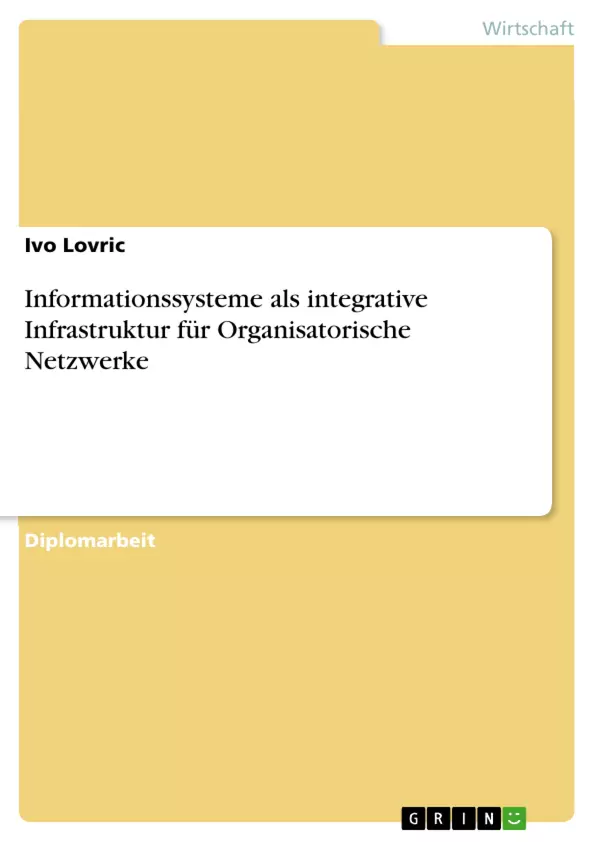Immer mehr Unternehmen erkennen mögliche Synergien, die sich durch Vernetzung mit Partnern ergeben. Manche Unternehmen werden sogar dazu gezwun-gen, um auf lange Sicht möglichst profitabel wirtschaften zu können. Ein solches Beispiel stellt die im Jahr 2005 geschaffene Allianz zwischen Daimler (ehemals DaimlerChrysler), BMW und General Motors (GM) dar.
Knackpunkt war das Jahr 1997, als Toyota das weltweit erste Hybridauto auf den Markt brachte. Der anfangs von den anderen Automobilherstellern mit Hohn und Spott bedachte Hybridantrieb entwickelte sich zu einer Schlüsseltechnologie der Zukunft. Dieser Trend veranlasste Daimler, BMW und GM sich zusammenzuschließen, um gemeinsam, durch Bündelung von Wissen und Kompetenzen etc., Toyotas Vorsprung einzuholen. Derartige Netzwerkstrukturen sind in jeder Branche anzutreffen, egal ob nun in der Automobilindustrie, der Versicherungsbranche oder in der Medizintechnik. Dabei ist die Mannigfaltigkeit der gegenwärtig existierenden Netzwerkformen, die dem Leser beim Studium der Fachliteratur entgegen kommt, erdrückend. In die Liste der diskutierten Netzwerkformen reihen sich mehr oder weniger bekannte Beispiele wie die oben erwähnten (strategischen) Allianzen, Joint Ventures, Zuliefernetzwerke, F&E-Netzwerke etc. ein. Die Umsetzung solcher Strukturen wird durch den Einsatz von Informations- und Kommunikationssystemen maßgeblich unterstützt. Sie sollen die Koordination der Partner untereinander und die des Netzwerkgeschäfts unterstützen. Viele der auf dem Markt existierenden Informations- und Kommunikationssysteme erlauben mittlerweile die Integration von unternehmensübergreifenden Geschäftsprozessen, die für die organisatorischen Netzwerke charakteristisch sind. Möglich machen dies die weit entwickelten technischen Infrastrukturen der Systeme.
Die Systeme müssen auf die Anforderungen in organisatorischen Netzwerken abgestimmt werden. Technisch gesehen ist die Anpassung an netzwerkartige Strukturen gegeben, wie sich im Laufe der Arbeit zeigen wird. Um aber eine optimale, integrative Wirkung dieser Systeme zu erzielen, werden zudem organisatorische Instrumente benötigt.
Inhaltsverzeichnis
- 1. Einleitung
- 1.1 Problemstellung
- 1.2 Zielsetzung
- 1.3 Vorgehensweise
- 2. Netzwerkorganisationen
- 2.1 Organisatorische Netzwerke
- 2.1.1 Enge und weite Sichtweise des Begriffs Netzwerk
- 2.1.2 Netzwerke als Hybride zwischen Markt und Hierarchie
- 2.2 Netzwerkkomplexität als Anforderungen an Informationssysteme
- 2.2.1 Vielzahl und Vielfalt
- 2.2.2 Vieldeutigkeit und Veränderlichkeit
- 2.2.3 Netzwerkschichten
- 2.2.4 Conjoint-Strukturen
- 2.2.4.1 Conjoint-Archetypen
- 2.2.4.2 Conjoint-Architekturen
- 2.3 Zusammenfassung der Anforderungen
- 2.4 Infrastrukturmodell – Grundlagen
- 2.5 Wertnetz
- 3. Integration von Informationssystemen
- 3.1 Integration
- 3.2 Integrationsobjekte
- 3.3 Integrationsformen
- 3.4 Integrationsziele
- 3.5 Integrationsgrad
- 3.6 Integrationsstrategien
- 4. Infrastruktur eines Informationssystems in einem organisatorischen Netzwerk
- 4.1 Kernprozesse in einem organisatorischen Netzwerk
- 4.2 Integrative Infrastruktur eines Informationssystems
- 4.2.1 Technokratische Integrationsinstrumente
- 4.2.2 Strukturelle Integrationsinstrumente
- 4.2.3 Personelle Integrationsinstrumente
- 4.2.4 Informationelle Integrationsinstrumente
- 4.2.5 Kulturelle Integrationsinstrumente
- 5. Informationssysteme in Netzwerken
- 5.1 Kriterien bei der Auswahl der zu betrachtenden Informationssysteme
- 5.2 Informationssysteme zur Kommunikation zwischen den Netzwerkpartnern
- 5.2.1 Computer Supported Cooperative Work (CSCW) – Systeme
- 5.2.1.1 Analyse der benötigten Integrationsinstrumente für eine integrative Infrastruktur von CSCW - Systemen
- 5.2.1.2 Fazit CSCW - Systeme
- 5.2.1 Computer Supported Cooperative Work (CSCW) – Systeme
- 5.3 Informationssysteme zur standardisierten Datenübertragung/ -austausch
- 5.3.1 EDI/WebEDI
- 5.3.1.1 Analyse der benötigten Integrationsinstrumente für eine integrative Infrastruktur von EDI / WebEDI
- 5.3.1.2 Fazit EDI / WebEDI
- 5.4 Konzepte zur Kopplung von Informationssystemen
- 5.4.1 Middleware
- 5.4.1.1 Analyse der benötigten Integrationsinstrumente für eine integrative Infrastruktur der Middleware
- 5.4.1.2 Fazit Middleware
- 5.4.2 SOA Web Services
- 5.4.2.1 Analyse der benötigten Integrationsinstrumente für eine integrative Infrastruktur von SOA - Web Services
- 5.4.2.2 Fazit SOA - Web Services
- 5.5 Informationssysteme für die Datenverarbeitung
- 5.5.1 Data Warehouse
- 5.5.1.1 Analyse der benötigten Integrationsinstrumente für eine integrative Infrastruktur von Data Warehouses
- 5.5.1.2 Fazit Data Warehouse
- 5.5.2 Enterprise Resource Planning (mySAP ERP – SAP NetWeaver)
- 5.5.2.1 Analyse der benötigten Integrationsinstrumente für eine integrative Infrastruktur von mySAP ERP
- 5.5.2.2 Fazit ERP (mySAP ERP - SAP NetWeaver)
- 5.6 Weitere Informationssysteme
- 5.6.1 Open-Source-Software
- 5.6.1.1 Analyse der benötigten Integrationsinstrumente für eine integrative Infrastruktur von Open-Source-Software
- 5.6.1.2 Fazit Open-Source-Software
- 5.6.2 Web 2.0
- 5.6.2.1 Analyse der benötigten Integrationsinstrumente für eine integrative Infrastruktur von Web 2.0
- 5.6.2.2 Fazit Web 2.0
- 6. Integrationsstrategien für die Einführung von interorganisationalen Informationssystemen
- 6.1 Beispielhafte Zuordnung der Informationssysteme und Konzepte zu den Integrationsstrategien
- 6.2 Zusammenfassung der Integrationsstrategienzuordnung
- 7. Praxisbeispiel BERU AG - SupplyOn
Zielsetzung und Themenschwerpunkte
Diese Arbeit untersucht die Rolle von Informationssystemen als integrative Infrastruktur für organisatorische Netzwerke. Ziel ist es, die Anforderungen an solche Systeme zu analysieren und geeignete Integrationsstrategien aufzuzeigen.
- Anforderungen von Informationssystemen in Netzwerkorganisationen
- Integrationskonzepte für Informationssysteme
- Analyse verschiedener Informationssystemtypen (z.B. CSCW, EDI, Middleware)
- Integrationsstrategien für die Einführung interorganisationaler Informationssysteme
- Praxisbeispiel zur Veranschaulichung
Zusammenfassung der Kapitel
Kapitel 1 führt in die Thematik ein und definiert die Problemstellung sowie die Zielsetzung der Arbeit. Kapitel 2 beschreibt organisatorische Netzwerke und deren spezifische Anforderungen an Informationssysteme. Kapitel 3 behandelt verschiedene Integrationskonzepte und -strategien für Informationssysteme. Kapitel 4 fokussiert auf die integrative Infrastruktur eines Informationssystems innerhalb eines organisatorischen Netzwerks. Kapitel 5 analysiert verschiedene Informationssysteme hinsichtlich ihrer Eignung für den Einsatz in organisatorischen Netzwerken und deren Integrationsbedarf. Kapitel 6 beschreibt beispielhaft die Zuordnung von Informationssystemen zu Integrationsstrategien. Kapitel 7 präsentiert ein Praxisbeispiel.
Schlüsselwörter
Organisatorische Netzwerke, Informationssysteme, Integration, Interorganisational, Netzwerkkomplexität, Integrationsstrategien, CSCW, EDI, Middleware, SOA, Data Warehouse, ERP, Open-Source-Software, Web 2.0.
- Quote paper
- Dipl.-Kfm. technisch Ivo Lovric (Author), 2007, Informationssysteme als integrative Infrastruktur für Organisatorische Netzwerke, Munich, GRIN Verlag, https://www.grin.com/document/120496



